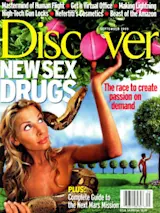What color is the cosmos? Planets, nebulae, and galaxies appear wan and faint when eyed through a backyard telescope. But researchers using imaging techniques show us a much more chromatic view.
That's right, the colors in many familiar photographs of the cosmos are fake. For more than 20 years, space agencies have embellished images of the heavens. Some of the images have to be enhanced: Photos assembled from wavelengths beyond the eye's perception have no color, so researchers paint them any way they choose. Venus, for example, has invisible cloud patterns that show up in infrared photos; NASA depicts them in orange and blue. Similarly, X-ray detectors reveal invisible galactic structures. Researchers color-code these features according to wavelength or temperature.
False color, for the sake of drama, got a lot of reinforcement when the giant outer planets were photographed during the Voyager mission in the late 1970s and 1980s. Researchers intensified color and contrast to maximize detail, and the media fell in love with the brilliant images.
When Voyager 2 reached Neptune in 1989, the previously pale planet was promoted to sky blue with red tinges. Uranus was--and still is--presented as lime green. No scientific principles justify these embellishments; Uranus is featureless. Without detail to enhance, the planet needed a rich new color to get the attention of the press. Likewise, Mars has been painted circus red instead of pale pumpkin. And Jupiter's yellow-white bands and light pink Red Spot have been tweaked to orange and candy-apple red.
Colorization is not confined to images from deep-space probes. Consider the celebrated 1995 Hubble photo, dubbed Pillars of Creation, by Jeff Hester and Paul Scowen of Arizona State University. This vivid image of the Eagle nebula's spirelike columns has graced the covers of astronomy magazines and has been made into a hit poster.
Through amateur telescopes these faint gas clouds appear gray and unexciting. Larger instruments sometimes show such nebulae as pale green because the retina responds to that tint in dim light. By contrast, photography brings out a dominant red emitted by the Eagle's hydrogen atoms. The universe is well stocked with these lovely cherry-red nebulae, thanks to hydrogen's omnipresence.
But such unvarying red can become tiresome after the first few thousand light-years of cosmic inventory. To avoid such monochromaticity, astronomers took separate pictures of the Eagle through different filters. Coloring each image with brilliant tints and bleeding them together yielded the spectacular hues of the Pillars of Creation.
Hester says his celebrated Hubble picture was merely intended to bring out scientific detail. The real Eagle nebula, he surmises, would look ghostly faint with pale, feeble colors. He calls his work an "artistic rendering of what the scientist sees."
Such artistic license is so commonplace that the presented universe bears little resemblance to the real thing. Instead, we have a cosmos in designer colors.














